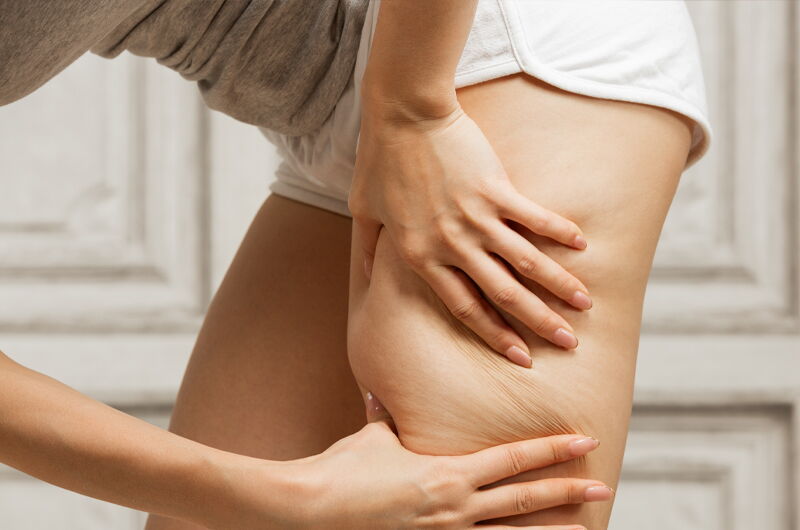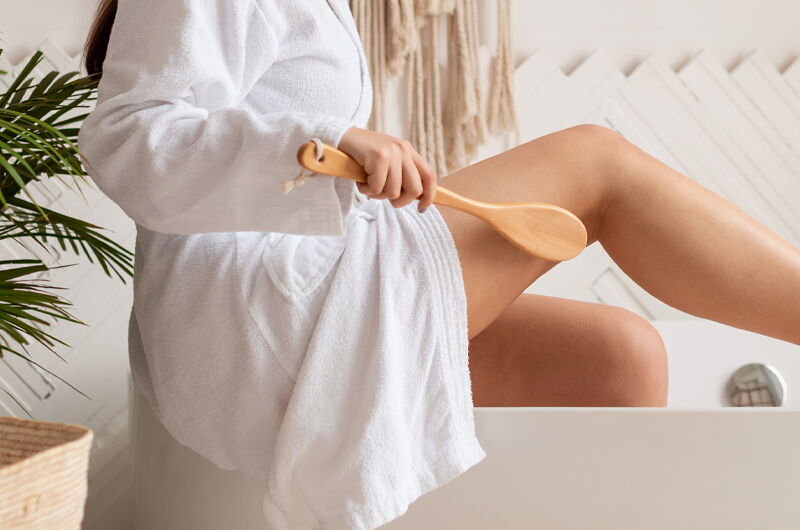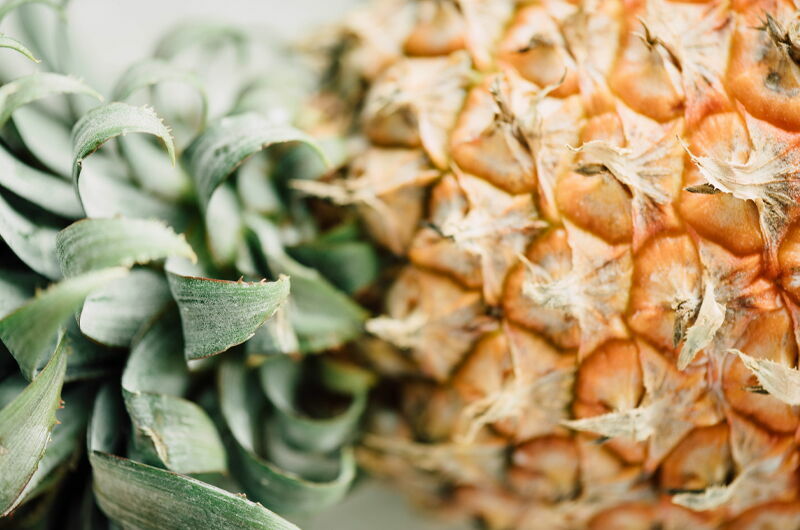With the arrival of the summer season the problem of water retention and cellulite becomes a nuisance for many women, who run for cover looking for quick results to reduce orange peel skin. Let's see how to approach the problem by analyzing why water retention and cellulite form and relying on safe and natural solutions to limit their aesthetic impact.
Water retention VS Cellulite

Before talking about potential remedies, it is good to clarify these two problems often confused with each other: cellulite and water retention.
Under our skin, we have a panniculus of adipose layer supported by reticular tissue and collagen, and vascularized by the microcirculation that brings (or removes) energy in the form of fat to the body, according to its needs. It often happens that the physiological balance is altered by:
- hormonal changes (cause of primary importance),
- unbalanced diet,
- liver dysfunction,
- sedentary lifestyle,
- situations of high stress,
- use of medications (see birth control pills),
- water retention itself.
In these cases, the cells of the adipose tissue break and release triglycerides into the intercellular spaces, which compress the microcirculation network, strongly altering its efficiency and favoring edema and "orange peel" skin. The circulatory and lymphatic systems also have the task of draining fluids and metabolic waste. An alteration of these systems facilitates the retention of liquids and toxins in the tissues and, therefore, of inflammatory processes in the adipose tissue. People with cellulite often also have peripheral circulatory problems such as venous insufficiency with insufficient lymphatic drainage. Water retention can also affect the presence of cellulite.
What is cellulite?
Cellulite, or edematous-fibro-sclerotic panniculopathy (PEFS), is a skin imperfection that mainly affects the female sex and prefers white women with an incidence around 80% - 90%. Cellulite is caused by the alteration processes of the subcutaneous fatty tissue. It manifests itself with the appearance of those small holes or depressions commonly identified as "orange peel skin" at the level of the thighs, buttocks, abdomen and / or hips.
Surely there is a genetic predisposition (hereditary) but obesity and overweight are also considered by many to be a strong element of risk and, in fact, even if thin women are not exempt from this pathology, they still have more limited manifestations. In particular, we are talking about swollen and painful legs where the accumulated fluids cannot rise upwards and stagnate in the lower limbs.
What is water retention?
Talking about water retention is not synonymous with cellulite, but it is certainly a condition that can favor its appearance. Water retention is an imbalance between the venous and lymphatic systems and is characterized by the presence of generalized subcutaneous edema, due to insufficient drainage of liquids, favored by the tendency of the cells to retain liquids, toxins and mineral salts.
Usually, water retention is caused by an imbalance between two specific mineral salts, potassium and sodium, which aggravate the poor efficiency of the lymphatic system in its activity, also affecting the upper limbs and the abdominal area. The causes that determine the onset of water retention are usually related to poor nutrition and a sedentary lifestyle. In the event that, in addition to microcirculation problems, real cellulite is also added, it is a sign that other factors may also be involved:
- hormonal imbalances (such as excess estrogen),
- taking medications (such as birth control pills),
- periods of severe stress and nervousness.
How to avoid the appearance of water retention - The basics

Both water retention and cellulite are disorders that, when present, accompany the subject throughout the year and deserve a much more constant approach. There is no escaping: lifestyle and healthy habits over time are fundamental. It is necessary to intervene with the synergy of:
- Healthy physical activity, which promotes circulation and metabolism.
- Targeted and balanced diet
- Really effective supplements and natural solutions
- Draining massages and application of specific creams
All this for a much longer period of the week before the "costume test"!
Water retention and nutrition
Nutrition plays a fundamental role in this imbalance, both as a cause and as a possible remedy. It is therefore important to establish whether the edematous swelling is linked to poor eating habits and / or overweight in order to be able to intervene. Per example, excess sodium increases water retention, as does an excessive intake of calories. They are then to be reduced:
- refined flours and carbohydrates,
- sweets,
- alcohol,
- dairy products,
- excess of saturated and trans fats.
From a dietary point of view, it is good to get help from a competent nutrition specialist in establishing the real caloric balance and the choice of an adequate dietary approach to support the microcirculation, the reduction of the inflammatory state and an efficient metabolism.
8 Phytoextracts that help reduce water retention

There are phytoextracts formulated to help counteract water retention and promote drainage thanks to a better activity of the lymphatic system. These supplements use a pool of natural elements with a marked draining, detoxifying and diuretic activity as the active ingredient. Here is a list of the best purifying and draining herbs that are on the market in the form of food supplements:
- Bromelain. The precious proteolytic enzymatic extract contained in the pineapple stem has a fibrinolytic action that acts on the blood vessels, reducing vasodilation and excessive permeability of the capillaries. Bromelain helps to alleviate inflammation or localized pain and gives pineapple an anti-edema, antiplatelet and coagulation modulating activity in venous insufficiency with a tendency to clot and thrombus formation. It is thus effective even in case of water retention and cellulite, thanks to its diuretic action due to the presence of organic acids, capable of stimulating the elimination of excess fluids.
- Dandelion. Also called dandelion due to its shape, it is a medicinal herb known since ancient times for its beneficial properties in the liver and as a diuretic. Dandelion is also used in the kitchen to dress salads but offers the best of itself as a natural drainage and anti-inflammatory adjuvant.
- Birch. Famous for its natural diuretic and lymphatic draining action, birch helps to increase the emission of urine, facilitating the elimination of excess fluids. With liquids, too many substances accumulated in the body, such as cholesterol and uric acids, also go away.
- Pilosella. An effective natural element that helps to counteract water retention and eliminate waste present in the body. It has a draining and diuretic function that synergistically binds very well to the other elements we have indicated. Excellent natural adjuvant for cellulite, pilosella stands out for its ability to reduce uric acids (typical of those who consume too much meat) thanks to the high content of flavonoids and to stimulate the production of bile, providing help for the well-being of the liver.
- Orthosiphon. It is another element produced by nature that boasts excellent diuretic properties, since it facilitates the elimination of sodium chloride and increases the urinary excretion of nitrogenous compounds such as uric acid. It is used not only for water retention problems, but also to counteract the formation and promote the elimination of gravel, phosphaturia and nephrolithiasis. These characteristics emerge thanks to the presence of active ingredients such as: saponins, flavonoids, polyphenols, polysaccharides, tannins, resins, mucilages that give the plant a purifying and diuretic action. Its diuretic and purifying action makes it useful in the presence of water retention, cellulite blemishes, gout and hyperuricemia.
- Bitter orange. Thanks to the presence of synephrine in particular , it stimulates beta-3 adrenergic receptors, present mainly in adipose tissue and in the liver, which are responsible for the processes of fat breakdown (lipolysis). Bitter orange acts on the lymphatic system, which makes it a useful extract in water retention.
- Rusco. It helps to counteract vasodilation and carries out phlebotonic activity due to the action of ruscogenin , a substance that makes the blood vessel wall more elastic, avoiding lymphatic stagnation. Thanks to these properties, butcher's broom is a good natural anti-edema remedy and is particularly suitable for relieving chronic venous insufficiency and related microcirculation disorders such as: night cramps, itching, heaviness in the legs, swelling, fatigue, and pain. to the limbs.
- Goldenrod. It is a plant with a purifying and anti-inflammatory action on the uro-genital system. It is characterized by a remarkable diuretic effect, which makes it a valid adjuvant in the treatment of urinary tract diseases and in the prevention of kidney stones. The Goldenrod can be considered a purifying support for the blood thanks to its property of increasing the volume of urine and eliminating nitrogenous waste and uric acids.
Combined with physical activity and a targeted diet, these plant extracts are a valid support to improve the appearance of water retention and cellulite. Seeing is believing!
References
- Peregalli PF. "Oral use of bromelin (ananase) in the treatment of edemas and hematomas, in orthopedico-traumatologic practice."Minerva Med. 1964 Dec 8;55:SUPPL:3932-5.
- Taussig SJ, Yokoyama MM, Chinen A, Onari K, Yamakido M. "Bromelain: a proteolytic enzyme and its clinical application. A review." Hiroshima J Med Sci. 1975 Sep;24(2-3):185-93.
- "Brome- lain."Plast Reconstr Surg. 2006 Dec;118(7):1640-4. Taussig SJ. The mechanism of the physiological action of bromelain. Med Hypotheses 1980;6:99-104.
- Therapeutic uses of pineapple-extracted bromelain in surgical care - A review.
- Muhammad ZA, Ahmad T. J Pak Med Assoc. 2017 Jan; 67 (1): 121-125.
- Properties and therapeutic application of bromelain: a review.
- Pavan R, Jain S, Shraddha, Kumar A. Biotechnol Res Int. 2012; 2012: 976203. Epub 2012 Dec 10. J Ethnopharmacol. 2015 Jan 15; 159: 62-83. doi: 10.1016 / j.jep.2014.11.010. Epub 2014 Nov 18.
- Medicinal plants of the genus Betula--traditional uses and a phytochemical-pharmacological review. Rastogi S1, Pandey MM2, Kumar Singh Rawat A2.
- An orientational examination of the effects of extracts from mixtures of herbal drugs on selected renal functions]. Ceska Slov Farm. 2007 Apr;56(2):85-9. Masteiková R1, Klimas R, Samura BB, Savickas A, Samura BA, Belaij SI, Samura IB, Rabisková M, Chalupová Z, Bernatoniene J.
- Medicinal plants of the genus Betula--traditional uses and a phytochemical-pharmacological review. J Ethnopharmacol. 2015 Jan 15;159:62-83. doi: 10.1016/j.jep.2014.11.010. Epub 2014 Nov 18. Studies on the antiinflammatory activity of Betula alnoides bark.
- Sur TK, Pandit S, Battacharyya D, Kumar CK, Lakshmi SM, Chatttopadhyay D, Mandal SC. Phytother Res. 2002 Nov;16(7):669-71. The diuretic effect in human subjects of an extract of Taraxacum officinale folium over a single day.
- Clare BA, Conroy RS, Spelman K. J Altern Complement Med. 2009 Aug;15(8):929-34. doi: 10.1089/acm.2008.0152.The action of Taraxacum officinale extracts on the body weight and diuresis of laboratory animals.
- Rácz-Kotilla E, Rácz G, Solomon A. Planta Med. 1974 Nov;26(3):212-7. No abstract available. Urolithiasis and phytotherapy. Grases F, Melero G, Costa-Bauzá A, Prieto R, March JG.
- Int Urol Nephrol. 1994;26(5):507-11.
- J Am Pharm Assoc (Wash). 2001 Jul-Aug;41(4):617.Pharmacy through the ages. Taraxacum officinale.
- Worthen DB1. Anti-inflammatory activity of Taraxacum officinale.
- Jeon HJ, Kang HJ, Jung HJ, Kang YS, Lim CJ, Kim YM, Park EH. J Ethnopharmacol. 2008 Jan 4;115(1):82-8. Epub 2007 Sep 15.
- F. Deodato, C. Di Stanislao and M. Corradin: Reasoned guide to the use of medicinal plants CEA Ed. 2011 Milan
- Capasso F., Grandolini G., Izzo AA Phytotherapy-Rational use of herbal drugs. Ed. Springer, 2006.
- Vanscheidt W. et al. Efficacy and safety of a Butcher's broom preparation (Ruscus aculeatus L. extract) compared to placebo in patients suffering from chronic venous insufficiency. Arzneimittelforschung 52, 243-250, 2002.
- Beltramino R. et al. An open-label, randomized multicenter study comparing the efficacy and safety of Cyclo 3 Fort versus hydroxyethyl rutoside in chronic venous lymphatic insufficiency. Angiology 51, 535-544, 2000.
- Cappelli R. Use of extract of Ruscus aculeatus in venous disease in the lower limbs. Drugs Exp. Clin. Res. 14, 277-283, 1988.
